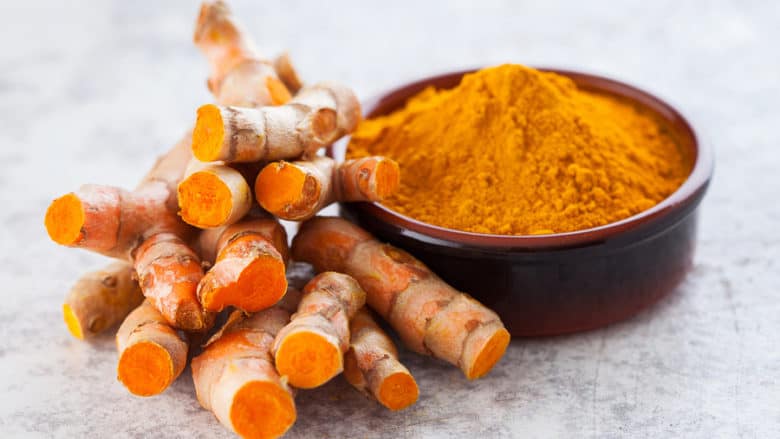
Turmeric benefits make it revered as a “Holy Powder” in India. Its reputation in India is so great that it is a symbol of health and long life and is used in religious and other ceremonies.
Gold-colored turmeric comes from the root of the Curcuma longa plant found in Asia and Africa. Related to ginger, it is widely used as a spice, a food preservative, a dye, and to treat various conditions.
Its use as a spice contributes to the color and taste of curry powders, mustards, and cheeses.
In India and the rest of Asia it has long been used to treat aches and pains, gastrointestinal problems, wounds, sprains, liver, and skin conditions.
It’s a staple of India’s traditional Ayurvedic medicine.
For instance, researcher, Ayyalusamy Ramamoorthy (we look at his fascinating research later) shared his personal experience in ScienceDaily:
- Antioxidant
- Anti-inflammatory
- Antiviral
- Antibacterial
- Antifungal
- Anticancer activities
The National Center for Complementary and Alternative Medicine (NCCAM) reports that there is little reliable evidence to support the use of turmeric for any health condition because few clinical trials have been conducted.
NCCAM is working to correct this by funding studies on turmeric’s role in preventing acute respiratory distress syndrome, liver cancer, and post-menopausal osteoporosis.
Here is a sampling of studies showing turmeric benefits for cancer, gastrointestinal conditions, diabetes, and arthritis.
Cancer: Curcumin has anti-inflammatory, antiviral, and antifungal effects found a review of studies published between 2008 and 2011 done by researchers in Israel.
They also found it improved immune and cell functions important for cancer prevention and treatment.
Gastrointestinal: Curcumin’s ability to be absorbed in the intestinal tract as well as its anti-inflammatory, antioxidant, and anticancer potential make it well suited for treating gastrointestinal diseases such as inflammatory bowel diseases, hepatic fibrosis, and gastrointestinal cancers reports a 2011 study published in the World Journal of Gastrointestinal Pathophysiology.
Diabetes: Curcumin’s effect on cells may make it useful in the treatment and prevention of obesity related chronic diseases such as diabetes reports a 2001 study published in the European Journal of Nutrition. Further, study authors say:
“Yes,” turmeric and its active compound, curcumin are effective for rheumatoid arthritis and other inflammatory conditions, say the authors, though the evidence is limited.
How Turmeric Benefits Work
Using technology termed solid-state NMR spectroscopy that can look into the structure of cells, researchers found the mechanism for how turmeric works in natural healing.
Molecules of curcumin insert themselves into cell membranes, making them more orderly, found University of Michigan researchers led by Ayyalusamy Ramamoorthy.
This move improves cells’ resistance to infection and malignancy, reports Ramamoorthy in ScienceDaily:
Turmeric, used in curry is a staple of Indian cooking. Use it as a spice with chicken, turkey, salad dressings, salads, soups and especially cruciferous vegetables (cauliflower, broccoli, kale, or Brussels sprouts).
However, if you use curcumin as a medicine to treat a condition, its hard to get enough from diet alone. Dr. Duke recommends adding as much to your diet as possible and taking turmeric supplements (standardized to include 90 to 95 percent curcumin).
Dr. Andrew Weil suggests using turmeric and curcumin supplements that contain piperine or black pepper extract.
Key Points
Turmeric has been used as a healing herb for centuries in traditional Indian medicine for the treatment and prevention of a whole host of conditions. Now Western science shows its benefits as well, though more studies are needed.
To enjoy turmeric benefits make it a regular spice in your dishes and use it with black pepper to increase its absorption.
When using it as a medicine, take its bioactive agent, curcumin as a supplement to make sure you are getting a therapeutic dose.
Sources and Resources
Aggarwal BB and Harikumar, KB, “Potential therapeutic effects of curcumin, the anti-inflammatory agent, against neurodegenerative, cardiovascular, pulmonary, metabolic, autoimmune and neoplastic diseases,” International Journal of Biochemistry and Cell Biology, 2009 Jan;41(1):40-59. Epub 2008 Jul 9.
Barry, Jeffrey; Fritz, Michelle; Brender, Jeffrey; Smith, ES; Dong-Kuk Lee and Ramamoorthy, Ayyalusamy, “Determining the Effects of Lipophilic Drugs on Membrane Structure by Solid-State NMR Spectroscopy: The Case of the Antioxidant Curcumin,” Journal of the American Chemical Society, 2009, 131 (12), pp 4490–4498.
Duke, James A., The Green Pharmacy Guide to Healing Foods: Proven Natural Remedies to Treat and Prevent More Than 80 Common Health Concerns (Rodalestore.com: Rodale, 2008).
National Center for Complementary and Alternative Medicine, “Herbs at a glance, Turmeric,” http://nccam.nih.gov/health/turmeric/ataglance.htm.
Rajasekaran, Sigrid, A, “Therapeutic potential of curcumin in gastrointestinal diseases,” World Journal of Gastrointestinal Pathophysiology, 2011 Feb 15;2(1):1-14.
Schaffer, M; et al., “Curcuma as a functional food in the control of cancer and inflammation,” Current Opinion in Clinical Nutrition and Metabolic Care, 2011 Nov;14(6):588-97.
Shehzad, A; et al., “New mechanisms and the anti-inflammatory role of curcumin in obesity and obesity-related metabolic diseases,” European Journal of Nutrition, 2011 Apr;50(3):151-61. Epub 2011 Mar 27.
University of Michigan. “Turmeric Ingredient Makes Membranes Behave For Better Health.” ScienceDaily, 6 Mar. 2009. Web. 26 Apr. 2012.
Weil, Andrew, Eight Weeks to Optimum Health, Revised Edition: A Proven Program for Taking Full Advantage of Your Body’s Natural Healing Power(New York: Ballantine Books, 2007).
White, B; Judkins, DZ, “Clinical Inquiry. Does turmeric relieve inflammatory conditions?” The Journal of Family Practice, 2011 Mar;60(3):155-6.
